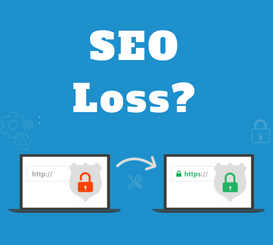
SEO loss in moving from HTTP to HTTPS
Back in the early days, when Google had just initiated the idea of secured transfer of information, it didn’t want the users to trust it with the security blindly. Instead, it made sure that the users know which website is secured and which is not by shifting the URL from ‘http’ to ‘https’.
When you migrate your website from HTTP to HTTPS, it is a new entity for Google. So, how would Google know that the link without S and with S is the same and yours? While with a secured transfer protocol your website will rank higher because of security benefits, but your ranking may even drop down, if not appropriately embedded. What are the factors that lead to a loss in ranking when a website shift from HTTP to HTTPS?
1. Time
When a website shifts from HTTP to HTTPS with the SSL certificate, the crawling time of the search engine increases. Since the secured link is a new link for the crawler, or more like a new website, it takes time to cache the information and display it to the user in the searched results. While the crawling time rises, the uptime of the website falls. When the user types a URL that has recently shifted from HTTP to HTTPS, the server takes its own time to route the website to the user. With this, the updation time of a website ascends too.
2. Performance issue
Yeah, right, the data shared on your website will be secured because of the security-socket layer certificate, but will it benefit the performance of your website? For the starters, your website will face numerous performance issues for the bots to cache the information to be displayed. Thence, making the performance of your website slow than usual. If your website has recently changed its URL from HTTP to HTTPS without properly examining every aspect, then your website is bound to face performance issues.
3. 301 redirect
So you have made a wise decision by moving from HTTP to HTTPS, but have you redirected all the old links to the new link for the crawler? 301 redirect is a permanent redirect of a website which has changed its HTTP status. Most of the people redirect their homepage URL but forget to redirect the internal pages of a website. When you do not redirect the links to internal pages, you confuse the bots for it to sweep in the information. Either you can redirect the link, or you can add HTTPS to the XML sitemap of your website.
4. Rel = Canonical
The rel= canonical element in the code of a website is to denote duplicate content. When your website with HTTP and HTTPS links are two entities for Google to crawl, adding the rel=canonical element in the code will prevent Google to entitle it to copied content.
5. Mixed content
Let’s assume that your fashion blog is encrypted, but some of the images inserted in the website are not from an encrypted source. In other words, your website is a product of HTTPS, but the image embedded in it is a part of HTTP, making it a mixed content. Mixed content on a website will prove a loss for the optimisation of your website as your website is still not secured for the user.
Although the security socket layer helps you with the boosting in the ranking of your website, you still should choose a quiet time to make the change. Don’t rush into moving from HTTP to HTTPS when your website has busy days.

